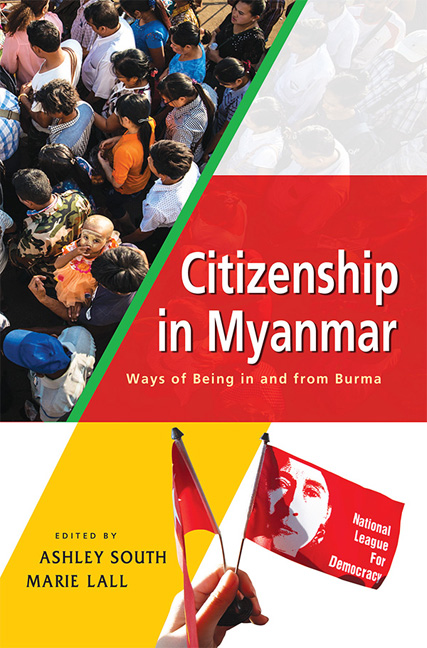Book contents
- Frontmatter
- Dedication
- Contents
- Foreword
- The Contributors
- Map of Myanmar
- Introduction
- 1 Ethnic Politics and Citizenship in History
- 2 Representation and Citizenship in the Future Integration of Ethnic Armed Actors in Myanmar/Burma
- Special Contribution: The Way Forward for Peace, Stability and Progress in Burma/Myanmar
- 3 National Political Dialogue and Practices of Citizenship in Myanmar
- 4 Citizenship and Minority Rights: The Role of “National Race Affairs” Ministers in Myanmar's 2008 Constitution
- Special Contribution: Karenni People at a Glance
- 5 Myanmar's Youth and the Question of Citizenship
- Special Contribution: I Am a Citizen of Myanmar
- 6 “The Value of Life”: Citizenship, Entitlement and Moral Legibility in Provincial Myanmar
- Special Contribution: How I Became Shan
- 7 Conflict and Mass Violence in Arakan (Rakine State): The 1942 Events and Political Identity Formation
- 8 Exploring the Issue of Citizenship in Rakhine State
- Special Contribution: Rohingya and Nationality Status in Myanmar
- 9 Myanmar's Other Muslims: The Case of the Kaman
- Special Contribution: Interview with P'doh Kweh Htoo Win
- Index
7 - Conflict and Mass Violence in Arakan (Rakine State): The 1942 Events and Political Identity Formation
Published online by Cambridge University Press: 28 June 2018
- Frontmatter
- Dedication
- Contents
- Foreword
- The Contributors
- Map of Myanmar
- Introduction
- 1 Ethnic Politics and Citizenship in History
- 2 Representation and Citizenship in the Future Integration of Ethnic Armed Actors in Myanmar/Burma
- Special Contribution: The Way Forward for Peace, Stability and Progress in Burma/Myanmar
- 3 National Political Dialogue and Practices of Citizenship in Myanmar
- 4 Citizenship and Minority Rights: The Role of “National Race Affairs” Ministers in Myanmar's 2008 Constitution
- Special Contribution: Karenni People at a Glance
- 5 Myanmar's Youth and the Question of Citizenship
- Special Contribution: I Am a Citizen of Myanmar
- 6 “The Value of Life”: Citizenship, Entitlement and Moral Legibility in Provincial Myanmar
- Special Contribution: How I Became Shan
- 7 Conflict and Mass Violence in Arakan (Rakine State): The 1942 Events and Political Identity Formation
- 8 Exploring the Issue of Citizenship in Rakhine State
- Special Contribution: Rohingya and Nationality Status in Myanmar
- 9 Myanmar's Other Muslims: The Case of the Kaman
- Special Contribution: Interview with P'doh Kweh Htoo Win
- Index
Summary
Following the Japanese invasion of Lower Burma in early 1942, the British administration in Arakan1 collapsed in late March/early April. In a matter of days, communal violence broke out in the rural areas of central and north Arakan (Akyab and Kyaukphyu districts). Muslim villagers from Chittagong who had settled in Arakan since the late nineteenth century were attacked, driven away or killed in Minbya, Myebon, Pauktaw and other townships of central Arakan. A few weeks later, Arakanese Buddhist villagers living in the predominantly Muslim townships of Maungdaw and Buthidaung were taken on by Chittagonian Muslims, their villages destroyed and people killed in great numbers. Muslims fled to the north while Buddhists fled to the south and from 1942 to 1945, the Arakanese countryside was ethnically divided between a Muslim north and a Buddhist south. Several thousand Buddhists and Muslims were relocated by the British to camps in Bengal. The unspeakable outburst of violence has been described with various expressions, such as “massacre”, “bitter battle” or “communal riot” reflecting different interpretations of what had happened. In the twenty-first century, the description “ethnic cleansing” would likely be considered as a legally appropriate term. Buddhists and Muslims alike see the 1942 violence as a key moment of their ongoing ethno-religious and political divide.
The waves of communal clashes of 1942 have been poorly documented, sparsely investigated and rarely studied. They are not recorded in standard textbooks on Burma/Myanmar and, surprisingly, they were even absent from contemporary reports and articles that described Burma's situation during and after World War II. From a historiographic point of view, the 1942 atrocities in Arakan may be considered as an example of the academic marginalization of the borderlands of Bengal/East Pakistan/Bangladesh and Arakan/Rakhine State in modern times. In 1952, B.R. Pearn, a professor of history from Rangoon University, wrote a confidential report for the Foreign Office on the Mujahid revolt that consumed North Arakan since 1948. The report contained a historical background that included the 1942 violence. However eight years earlier, Pearn himself had read a paper at the Royal Society of Arts in London (“Burma since the invasion”, 14 December 1944) that did not even hint at the forced displacement and the killings that had taken place two years before in Arakan (Pearn 1945; see also Bowerman 1946).
- Type
- Chapter
- Information
- Citizenship in MyanmarWays of Being in and from Burma, pp. 193 - 221Publisher: ISEAS–Yusof Ishak InstitutePrint publication year: 2017

